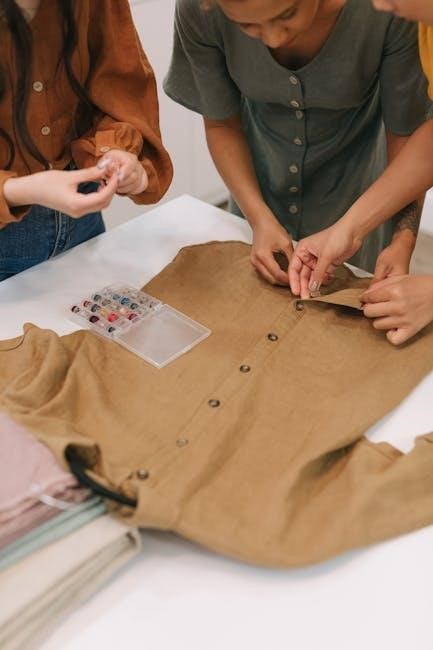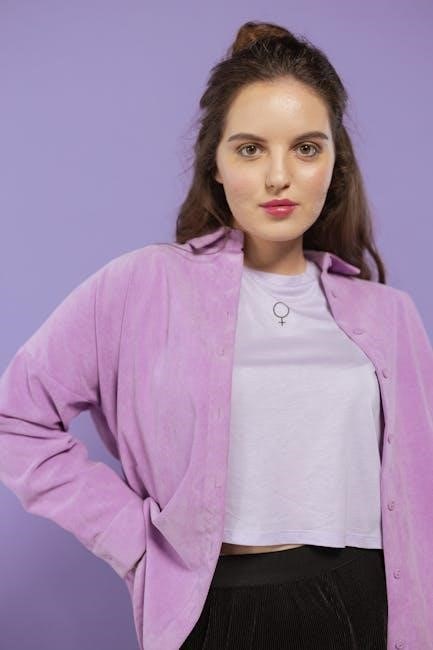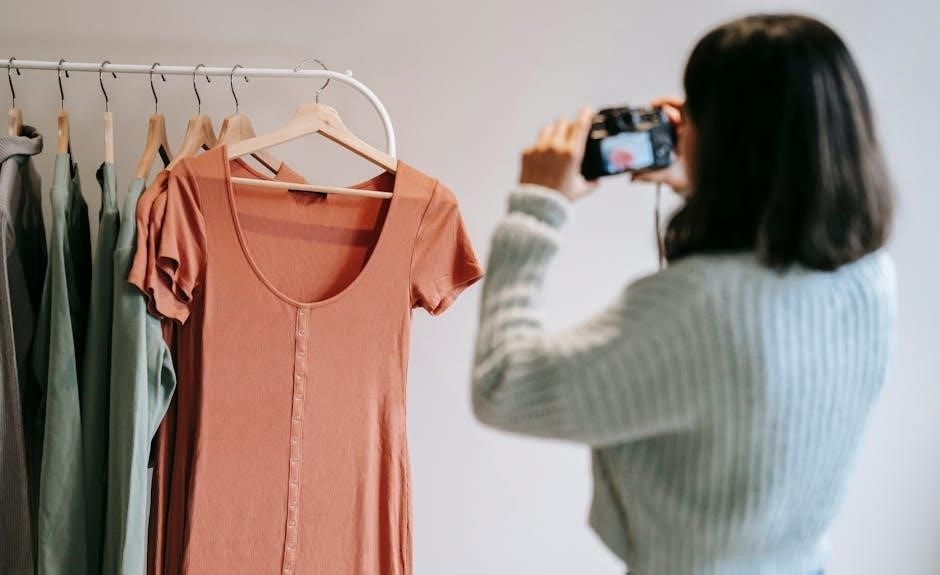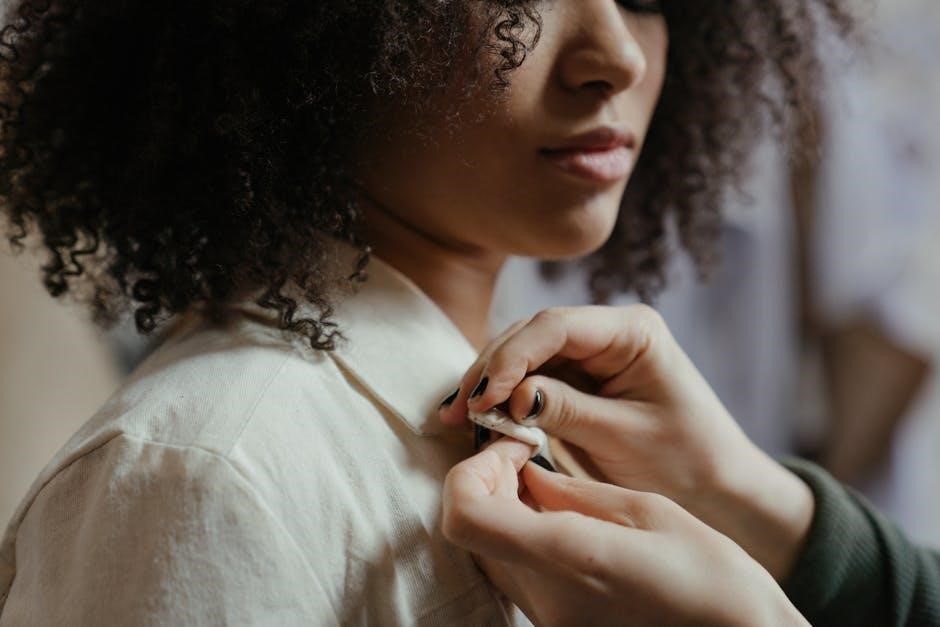Understanding Measurements for Button-Down Shirts
Accurate measurements are crucial for a perfect fit. Chest, shoulder, and sleeve length are key. Proper sizing ensures comfort and style, avoiding common fit issues like gaping or tightness.
Body Measurements for Accurate Sizing
Accurate body measurements are essential for selecting the right button-down shirt size. Measure your chest circumference at the widest point, shoulders from tip to tip, and natural waist for the best fit. Proper neck measurements ensure collar comfort. These measurements help avoid common issues like tightness or gaping, ensuring a comfortable and stylish wear. Always refer to a size chart for guidance, as sizing can vary between brands.
Shirt Measurements: Chest, Waist, and Length
Shirt measurements are critical for a tailored fit. Chest measurement is taken across the broadest part, while waist is measured naturally at the narrowest point. Shirt length varies, with longer styles designed to be tucked in and shorter options for a casual, untucked look. Proper measurements ensure the shirt drapes well, avoiding boxiness or tightness. These dimensions, combined with body measurements, help determine the ideal size for comfort and style.

Fabric Type and Its Impact on Fit
Fabric type significantly influences fit. Heavier fabrics provide structure, while lighter ones drape softly. Seasonal weights and weaves affect comfort and sizing, ensuring optimal wearability year-round.
Cotton and Oxford Fabrics: Differences in Fit
Cotton fabrics offer a soft, breathable fit, ideal for casual wear. Oxford fabrics, with their unique weave, provide a slightly firmer texture and sharper appearance, often preferred for business settings. Both fabrics drape well but differ in formality. Cotton is more relaxed, while Oxford gives a crisp, structured look. Understanding these differences helps in selecting the right fabric for the desired fit and occasion.
Seasonal Fabrics: How Weight Affects Size
Seasonal fabrics vary in weight, impacting fit. Lighter fabrics like linen or seersucker are ideal for summer, offering a relaxed fit without clinging. Heavier fabrics, such as flannel or wool blends, are suited for winter, providing warmth but potentially feeling tighter. Understanding fabric weight helps in choosing the right size, ensuring comfort and a flattering fit across seasons.
Fit Style: Choosing the Right Cut
Fit style determines comfort and appearance. Slim, regular, or relaxed cuts cater to different body types. Choose based on personal comfort and desired aesthetic appeal.
Slim Fit vs. Regular Fit: Pros and Cons
A slim fit offers a modern, tailored look, ideal for slimmer builds, but may feel restrictive for broader frames. Regular fit provides comfort and versatility, suitable for most body types, while maintaining a classic style. Choose based on body type and personal preference for optimal comfort and aesthetics. Proper fit ensures both functionality and polished appearance in any setting or occasion.
Relaxed Fit: When and How to Wear It
A relaxed fit offers a comfortable, looser cut ideal for casual settings. Perfect for weekends, outdoor activities, or layering over a T-shirt. It suits larger or broader frames, providing ease of movement. Pair with jeans for a laid-back look or dress pants for a slightly polished appearance. This style balances comfort and style, making it versatile for everyday wear while maintaining a relaxed yet put-together aesthetic.

Determining Your Ideal Size
Measure chest, shoulders, and sleeve length accurately. Compare with brand-specific charts to ensure the best fit. Consider fabric type and desired style for optimal comfort and appearance.
Using Body Measurements for Size Selection
Accurate body measurements are essential for selecting the right size. Measure your chest, shoulders, and sleeve length carefully. Compare these measurements to the size chart provided by the brand. Ensure the shirt fits comfortably, with enough room for movement. Consider the style and fabric type, as these can affect the fit. Always check brand-specific sizing charts, as measurements may vary. Proper fit ensures both comfort and a polished appearance, making it worth the extra effort to get it right.
Guidelines for Sleeve Length and Collar Fit
Ensure sleeves hit mid-hand for a balanced look. Collars should fit snugly without gaping. Address common issues like tightness by adjusting measurements. Proper fit enhances comfort and style, avoiding discomfort or unflattering appearances. Use practical solutions to customize your shirt’s fit without alterations. Sleeve length should allow slight bending of elbows. Collar fit should be firm but not restrictive. Achieve a polished look by addressing these key areas, ensuring your button-down shirt feels and looks its best.

Brand Differences in Sizing
Brands vary in sizing due to fabric, cut, and fit styles. Some offer tailored, slim, or relaxed fits, impacting measurements and comfort differently across labels.
Why Sizing Varies Between Brands
Brands use different patterns, fabrics, and fits, leading to size variations. Some cater to specific body types or styles, while others focus on comfort or fashion, affecting measurements.
How to Use Brand-Specific Sizing Charts
Always refer to the brand’s sizing chart for accurate measurements. Compare your body measurements to their chart, ensuring the best fit. Consider fabric type and style, as these can affect size. Double-check sleeve length and chest circumference to avoid ill-fitting shirts. Proper use of sizing charts ensures a comfortable and flattering fit tailored to your body type and the brand’s design.

Common Fit Issues and Solutions
Addressing fit problems like shoulder tightness or gaping collars improves comfort. Adjustments such as tailoring or using collar stays can enhance fit and appearance effectively.
Addressing Shoulder and Sleeve Fit Problems
Shoulder fit issues can cause discomfort and affect the shirt’s appearance. If the shoulders are too tight, consider a larger size. For sleeves, ensure they aren’t too long or short. Proper sleeve length should reach the wrist bone when arms are relaxed. Adjustments like tailored alterations can resolve these fit problems, ensuring a comfortable and polished look without compromising style or functionality.
Fixing Gaping Collars and Tight Waistbands
Gaping collars can be resolved with collar stays or adjusting the fit. Tight waistbands may require a larger size or a relaxed fit style. Tailoring can also help. Ensuring the shirt isn’t too tight or too loose around the torso improves comfort and aesthetics, making the shirt look and feel its best for any occasion.

How to Measure for a Button-Down Shirt
Measure chest circumference, shoulder width, sleeve length, and neck size. Use a flexible tape measure, keeping the shirt buttoned. Ensure a snug but comfortable fit for accuracy.
Measuring Chest and Shoulder Circumference
Measure chest circumference by wrapping a flexible tape measure around the widest part of your chest, keeping the tape level and parallel to the ground. For shoulder circumference, measure across the back from one shoulder tip to the other. Ensure the shirt is buttoned and lies flat for accurate measurements. These measurements are critical for determining the ideal fit and avoiding issues like tightness or excessive looseness in the upper body area.
Calculating Sleeve Length and Neck Size
To determine sleeve length, measure from the center back of your neck to your wrist, keeping your arm relaxed. For neck size, wrap a tape measure around the base of your neck, leaving enough space for one finger. These measurements ensure sleeves are neither too short nor too long and the collar fits comfortably. Accurate calculations help in selecting the perfect size, ensuring both comfort and a polished appearance.

Caring for Your Button-Down Shirt
Wash shirts inside out in cold water to preserve fabric and color. Avoid over-drying to maintain shape and softness. Iron while slightly damp for a crisp look.
Washing and Drying Tips for Longevity
For lasting quality, wash button-down shirts inside out in cold water to protect fabric and colors. Avoid using harsh detergents or bleach. Gently tumble dry on low heat or air-dry to prevent shrinkage and maintain shape. Remove promptly to avoid wrinkles. Iron while damp for a crisp finish, paying attention to collars and cuffs. Proper care ensures your shirt stays pristine and retains its fit over time.
Ironing Techniques to Maintain Fit
Ironing is essential for maintaining the shape and appearance of your button-down shirt. Start with the collar, ironing the underside first, then the topside. Use steam for wrinkles and medium heat to avoid scorching. Iron sleeves from the shoulder down, smoothing fabric as you go; Tackle the yoke and back next, ensuring a crisp finish. Finally, iron the front panels and button placket. Avoid stretching the fabric while ironing to preserve the fit and prevent distortion.

Accessorizing Your Button-Down Shirt
Accessorizing enhances your shirt’s style. Use cufflinks, ties, or pocket squares to add flair. Ensure accessories complement the shirt’s color and pattern for a polished look.
Using Collar Stays for a Polished Look
Collar stays are essential for maintaining a crisp, professional appearance. They keep the collar rigid, preventing it from curling or sagging. Choose metal or plastic stays, depending on preference, and insert them into the collar slots before wearing. This simple addition ensures a sharp, put-together look, making your button-down shirt stand out in formal or business-casual settings. Properly secured collars enhance overall fit and style, making collar stays a must-have accessory for any shirt wearer aiming for a polished look. They are especially useful for thicker collars or those prone to losing shape, providing long-lasting structural integrity throughout the day.
Cufflinks: Enhancing Sleeve Closures
Cufflinks add elegance to button-down shirts by securely fastening the cuffs. They come in various styles, from simple to decorative, offering both functionality and personal expression. Choosing the right cufflinks complements the shirt’s fabric and design, elevating the overall look. Whether for a formal event or a business setting, cufflinks are a subtle yet impactful accessory that enhances the shirt’s appearance while ensuring a polished, tailored finish. They are a timeless detail that completes the outfit with sophistication and charm.

Specialized Fits: Tailored Options
Tailored fits offer unique sizing solutions, including tall, short, and big and tall options. These designs cater to specific body types, ensuring optimal comfort and style for all.
Tall and Short Fits: Finding Your Size
Tall fits cater to men over 6’1″ with longer sleeves and shirt lengths, while short fits suit men under 5’8″ with proportionally shorter measurements. Measure sleeve length from the center back to the wrist and shirt length from the base of the collar to the hip. These specialized fits ensure the shirt stays tucked in and maintains a tailored appearance. Tall fits often have slightly longer tails, while short fits are more streamlined to avoid overwhelming the frame.
Big and Tall Sizing: Where to Shop
Big and tall sizing is available at select retailers, both online and in-store. Brands like Brooks Brothers, Bonobos, and Club Monaco offer tailored fits for larger frames. Many department stores also carry dedicated big and tall collections. Always check the sizing chart specific to the brand, as measurements can vary. Reading customer reviews can also provide insights into fit and comfort, ensuring the best choice for your needs.
Understanding Shirt Length and Style
Shirt length dictates whether it’s for tucking in or casual wear. Longer styles flatter taller frames or formal settings; shorter fits perfectly suit relaxed occasions;
Regular vs. Tailored Fit Lengths
Regular fit shirts are longer in length, designed to be tucked into pants for a polished look. They suit formal occasions and taller individuals, providing a classic silhouette.
Tailored fit shirts are shorter and more streamlined, offering a modern, fitted appearance. They are versatile, suitable for both tucked and untucked styling, depending on the desired aesthetic.
Tucking In: When and Why
Tucking in a button-down shirt is ideal for formal events, business settings, or when aiming for a polished look. It creates a streamlined silhouette and prevents excess fabric from bunching up.
Untucked shirts are better suited for casual occasions or layering under sweaters. The choice depends on personal style and the desired aesthetic, ensuring comfort and confidence in any setting.

Seasonal Variations in Shirts
Seasonal shirts vary in fabric weight and weave. Lightweight fabrics like linen suit summer, while heavier fabrics such as flannel are ideal for winter, ensuring comfort year-round.
Fabric Weight: Summer vs. Winter
Fabric weight significantly impacts shirt comfort across seasons. Summer shirts use lightweight fabrics like linen or cotton for breathability, while winter opts for heavier materials such as flannel or wool for warmth. The weight affects both fit and functionality, ensuring seasonal appropriateness. Lighter fabrics drape elegantly in heat, while thicker textures provide insulation in cold weather. Choosing the right fabric weight ensures optimal comfort and style, making it a key factor in selecting button-down shirts for different times of the year.
Weave and Texture: Seasonal Preferences
Weave and texture play a significant role in seasonal shirt preferences. Summer shirts often feature lightweight weaves like plain weave or voile for breathability, while winter shirts use denser weaves such as twill or herringbone for warmth. Smooth textures like poplin are versatile, while rougher textures like tweed add a seasonal, cozy feel. The right weave and texture enhance comfort and style, making them essential considerations for button-down shirts tailored to specific times of the year.
By understanding measurements, fabric, and fit, you can confidently select the perfect button-down shirt. Proper care ensures longevity, while accessorizing enhances style for a polished, tailored look always.
Final Tips for the Perfect Fit
Ensure your button-down shirt fits seamlessly by tucking it in if designed for that style. Avoid gaping collars with collar stays and opt for fabrics that suit the season. Pair slim-fit shirts with tailored trousers for a polished look, while relaxed fits work well with jeans. Always refer to brand-specific sizing charts for accuracy and consider alterations for a bespoke feel. Balance style, comfort, and personal preference to make your button-down shirt a wardrobe staple.
